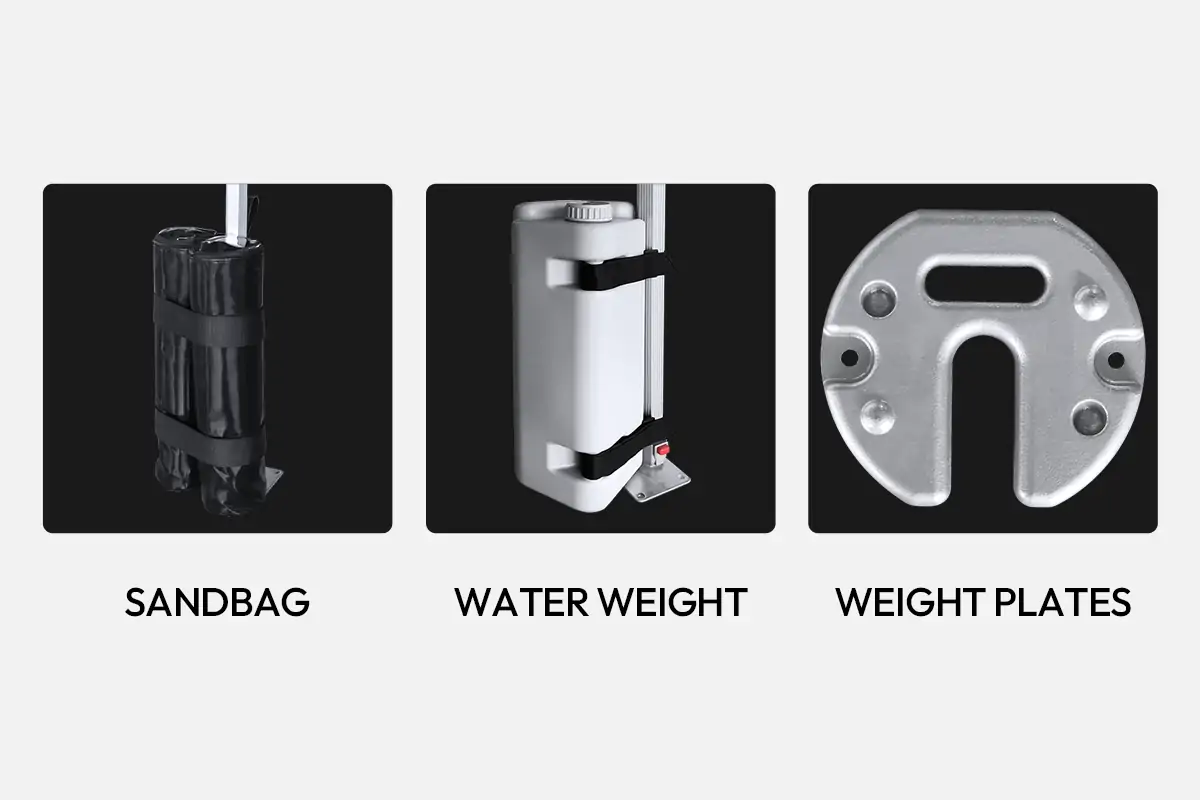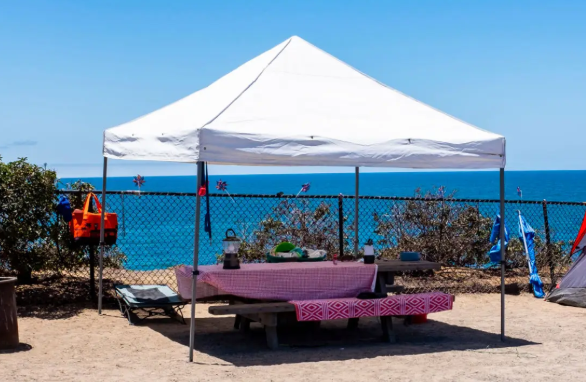
No one wants their tents to be taken away by the wind. It is important to secure your canopies to the ground. The required weight for securing a tent varies depending on the ground surface, weather conditions, and tent models. Do you know how much weight to hold down a 10×10 canopy?
This guide provides the recommended weight guidelines and tips for securing the canopy. It will help you determine the optimal weights for tents and securely hold down your canopy at outdoor events.
Factors Affecting Weight Requirements
Several factors affect the required weights for a tent. You need to consider where the tent is set up, the weather conditions, and the type of tent you use. Let’s explore these factors in detail to ensure your tent stays secure at your events.
Weather Condition
Wind is the main factor that determines the weights to hold down canopy. Each canopy tent features a specific level of wind resistance. You need to know how much wind can a canopy tent withstand first. Generally, a 10×10 canopy can withstand 30 to 40 MPH of wind. When wind isn’t a concern, you can choose lighter weights; while in gusty winds, you’d better increase the weight to prevent the tent from blowing away.
Ground Surface
The type of ground may influence the securing weight and methods for your tent. Compared to hard surfaces, soft ground surfaces are uneven and require heavier weight to stabilize a canopy. In addition, you can use stakes to better hold down the canopy.
Types of Tent
Different tent models feature varying levels of stabilization. Smaller-sized tents, like 10×10, require less weight to stay secured. The large pop up canopy and heavy-duty models require more weight to remain in place. Also, you need to know how much does a tent weigh to determine the optimal securing weight.
How Much Weight to Hold Down a 10×10 Canopy
A 10 x 10 canopy tent is the popular choice for markets, family activities, and trade shows. This size can provide shelter for people without taking up too much space.
Generally, we recommend using weights ranging from 25 to 40 pounds per leg for a 10×10 canopy frame. You should increase the weights for canopy legs as the tent size grows or in strong winds. In heavy wind, consider adding 50 to 100 pounds to each leg.
| Wind Speed(MPH) | Recommended Weight per Leg | Methods |
| 0–10 (Light) | 15–25 lbs | Light weights or small stakes. |
| 10–15 (Moderate) | 30–40 lbs | Use stakes or weights. |
| 15–25 (Strong) | 50–75 lbs | Weights or stakes + tie-downs. |
| 25–30 (Gusty) | 75–90+ lbs | Heavy weights + tie-downs. |
| 30+ (High Wind) | Do Not Use Canopy | Too dangerous—take it down. |
For the larger tents, such as 10×20 custom event tent, you’d better use weight bags with at least 370 lbs of weight in wind conditions. Their heavier frame and larger canopies require more weight to stay in place. Besides, heavy-duty tents also require heavier weights to hold them down. We recommend using at least 30 lbs per leg for a 10 x 10 heavy-duty canopy.
If you add sidewalls to your tent, you should increase the securing weight accordingly. A 10×10 tent with sides requires at least 50 pounds per leg to force the additional wind and lateral pressure. Additionally, if the wind becomes too strong, you had better remove the sidewalls to ensure safety.
How to Secure a Canopy
Securing your pop-up canopy tent is essential for ensuring stability and safety. You can use tent stakes or weights to hold down canopy. Let’s explore these methods in detail to learn how to secure your canopy effectively.
Stakes
Tent stakes are ideal for anchoring tents to grass or other soft surfaces. They are designed with a pointed end for easy insertion into the ground. You can use stakes to hold down the canopy through the following steps:
- Attach stakes to tent legs or frame with guy lines or straps.
- Insert stakes into the ground at a diagonal 45-degree angle.
- Make sure the stakes are firmly inserted into the ground.
Weights

Using weight bags for canopy is another effective method for anchoring your pop up tent. You can also choose weight plates, sandbags, or water weights for canopy based on your needs. By adding weights for canopy legs, you can improve the stability and wind resistance of the tents. This makes the tent less likely to collapse or be blown away.
Additionally, you can choose professional tools or diy tent weights. Consider purchasing professional accessories. They can withstand outdoor weather conditions for a long service life.
Westshade provides high-quality anchor tools. We offer heavy-duty weight plates that weigh 30 pounds each. A 30-pound weight plate for each tent leg is sufficient to hold down a 10×10 canopy. If you need extra weight, consider our sandbags, water barrels, or stacking multiple-weight plates.
Don’t Miss Our Christmas Sale! Save 20% sitewide from Dec 11 to Jan 5 with code CM2025.
FAQs
How much weight does it take to hold down a 20×20 canopy?
To hold down a 20×20 custom tent, you’ll need at least 100–150 lbs per leg, depending on wind and surface conditions (soft ground or strong winds require more). That totals 400–600 lbs minimum. In high winds (20+ MPH), consider additional anchoring or taking the canopy down for safety.
What can I use to weigh down my canopy?
You can use the following items to weigh down your canopy:
- Sandbags: Durable and easy to fill.
- Water weights: Convenient for transport and filling on-site.
- Concrete blocks or plates: Heavy but stable.
- Weight plates: Durable and professional.
- Tent anchors or stakes: Ideal for grass or soil surfaces.
- Buckets filled with sand, water, or gravel: Good DIY options.
How much wind can a 10×10 canopy hold?
Generally, a 10 x 10 pop up tent can withstand up to 25 MPH winds. If properly anchored, its wind resistance will be enhanced. However, lightweight models (especially aluminum frames) may become unstable above 15 MPH without adequate anchoring. In conditions exceeding 25 MPH, even well-anchored canopies are at risk and should be taken down to avoid damage or injury.
Conclusion
The required weight for a tent mainly depends on its location, weather conditions, and type. You’d better weigh 25 to 40 pounds on each leg of your 10×10 canopy. The larger the size, the more weight the tent needs. Additionally, if the wind gets stronger, you’ll need to add more weight to the tent legs.
If you are looking to purchase a canopy tent or accessories, check Westshade! We provide an array of high-quality outdoor equipment and weight solutions designed to meet your needs. If you have any questions about canopy weight bags or securing methods, visit Westshade for more information.
Plus, don’t miss our special Christmas Sale running from December 11th to January 5th—enjoy 20% off on all regular-priced items with code CM2025. It’s the perfect time to get everything you need for a safe and stylish outdoor setup at a great price.








